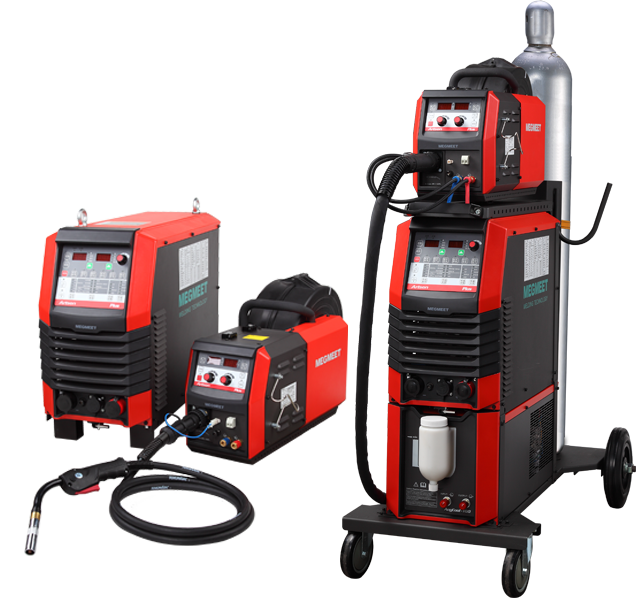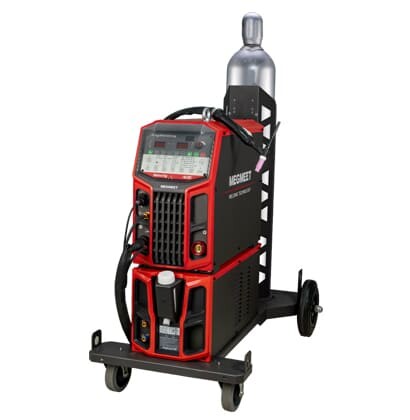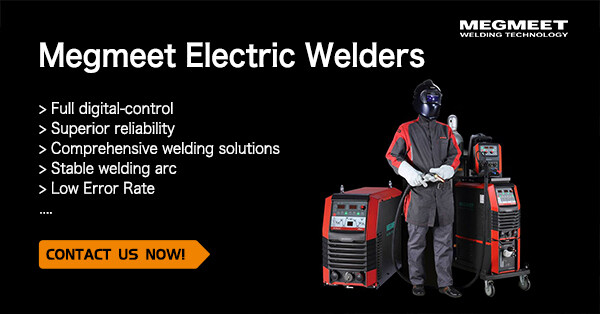We made a detailed comparison of MIG Welding and TIG Welding in the last article, and now we will compare the similarities and differences of another two welding processes under gas metal arc welding (GMAW): MIG welding VS. MAG Welding.
MIG welding and MAG welding are two common types of gas metal arc welding (GMAW) that use an electric arc to melt and join metal pieces. They are widely used in various industries, such as automotive, construction, and manufacturing. But what are the differences between MIG welding and MAG welding? And how can you choose the best welding method for your project? In this article, we will answer these questions and provide some tips on shielding gas selection and welder selection.
CONTENT:
I. Definition of MIG Welding and MAG Welding.
II. Similarities of MIG and MAG Welding.
III. Differences Between MIG and MAG Welding.
IV. Shielding Gas Selection in MIG and MAG Welding.
V. MIG and MAG Welder.
I. Definition of MIG Welding and MAG Welding.
1) What is MIG Welding?
MIG welding stands for metal inert gas welding. It is also known as gas metal arc welding (GMAW) or metal active gas (MAG) welding. MIG welding uses a continuous wire electrode that is fed through a welding gun and forms an arc with the workpiece. The arc creates a molten pool that fuses the metal pieces. A shielding gas, such as argon or helium, is also supplied through the welding gun to protect the weld pool from atmospheric contamination.

MIG welding is a versatile and easy-to-learn welding method that can weld various metals, such as steel, aluminum, copper, and nickel. It can also weld different thicknesses and shapes of metal, such as sheet metal, pipes, and plates. MIG welding is suitable for both indoor and outdoor applications, as long as the wind is not too strong to blow away the shielding gas.
2) What is MAG Welding?
MAG welding stands for metal active gas welding. It is a type of gas metal arc welding (GMAW) that uses a similar process as MIG welding, except that it uses an active shielding gas, such as carbon dioxide or a mixture of argon and carbon dioxide. The active gas reacts with the molten metal and forms a slag layer that covers the weld pool. The slag layer protects the weld from oxidation and spatter, but it also needs to be removed after welding.

MAG welding is mainly used for welding carbon steel and low-alloy steel, as the active gas provides better penetration and strength for these materials. MAG welding is also more economical than MIG welding, as the active gas is cheaper and the wire electrode consumption is lower. However, MAG welding produces more smoke and fumes than MIG welding, and it is more sensitive to the welding parameters, such as voltage, current, and wire feed speed.
II. Similarities of MIG and MAG Welding.
1) Welding Process: Both MIG and MAG welding are arc welding processes, and use a similar welding process where a wire electrode is continuously fed into the welding area, which melts and joins the metals together.
2) Shielding Gas: Both MIG and MAG welding require a shielding gas to protect the welding area from atmospheric contamination. In MIG welding, an inert gas such as argon is used, while in MAG welding, an active gas such as carbon dioxide is used.
3) Equipment: Both MIG and MAG welding require a power source, a wire feed unit, and a welding gun.
4) High Efficiency: Both welding processes can weld quickly and efficiently, and are used in a variety of applications in the manufacturing industry.
5) Versatility: Both MIG and MAG welding are versatile welding processes that can be used to weld a wide range of metals such as steel, aluminum, and stainless steel.
6) Low Spatter: Both welding processes produce minimal spatter during the welding process, resulting in a cleaner and smoother weld.
III. Differences Between MIG and MAG Welding.
| MIG Welding | MAG Welding |
| Shielding gas: | Uses chemically inert gas such as nitrogen, argon, helium, or a mixture of such gases as a shielding gas. | Uses a mixture of chemically active gas (like oxygen or carbon dioxide) and inert gas (like nitrogen, argon, or helium) as a shielding gas. |
| The integrity of the shielding gas: | No disintegration takes place during welding. | Chemically disintegrate during welding. |
Weld bead: | 1) No chemical elements are induced into the weld bead. 2) The chemical composition and properties of the weld bead are not altered. | 1) Certain chemical elements (like oxygen, carbon, etc.) are induced into the weld bead. 2)The chemical composition and properties of the weld bead are altered. |
| Welding flexibility: | Not flexible. | Flexible. |
| Welding application: | MIG welding is preferred for joining non-ferrous metals (like aluminum). | MAG welding is preferred for joining ferrous metals (like mild steel or stainless steel). |
| Welding cost: | Industrially pure inert gas cylinders for MIG welding are somewhat costlier. | Shielding gas cylinders for MAG welding is comparatively cheaper. |
IV. Shielding Gas Selection in MIG and MAG Welding.
As the main difference between MIG welding and MAG welding is the shielding gas, the selection of shielding gas is of great importance in the welding process. Selecting the right shielding gas helps protect the welding area from atmospheric contamination, ensuring a stable arc and high-quality weld. To select the appropriate shielding gas for your welding application, the factors to be considered are as follows:
1) Welding Material: The base material to be welded is the primary factor in selecting the appropriate shielding gas for MIG and MAG welding. For example, carbon steel can use either an inert gas such as argon or a mixture of active gases such as carbon dioxide and argon in MAG welding. Aluminum and other non-ferrous metals require an inert gas such as argon in MIG welding.
2) Welding Process: The welding process to be used is another important factor in selecting the appropriate shielding gas for MIG and MAG welding. For example, MIG welding generally uses an inert gas such as argon, while MAG welding typically uses a mixture of active gases such as carbon dioxide and argon.
3) Welding Position: The position of the weld, such as vertical, overhead, or flat, can also influence the selection of shielding gas for MIG and MAG welding. Active gases such as carbon dioxide are often used in flat position welding, while inert gases such as argon are better suited for vertical and overhead positions.
4) Welding Application: The specific application of the weld can also influence the selection of shielding gas for MIG and MAG welding. For example, the automotive industry often uses a mixture of active gases such as carbon dioxide and argon in MAG welding to increase welding speed and productivity.
5) Welding Cost: The cost of the shielding gas is also a consideration when selecting the appropriate gas for MIG and MAG welding. Inert gases such as argon are generally more expensive than active gases such as carbon dioxide, so cost may be a factor in selecting the appropriate gas.
V. Attentions of MIG and MAG Welding.
To better perform your MIG and MAG welding, here are some things for you to keep in mind:
1) Welding Safety: Wear appropriate protective gear, such as a welding helmet, gloves, and protective clothing, and work in a well-ventilated area.
2) Welding Preparation: Clean the welding surface thoroughly to remove any contaminants, and make sure the metal is dry and free of rust, grease, and other debris.
3) Welding Parameters: Set welding parameters such as voltage, current, and wire feed speed properly according to the type and thickness of the metal to be welded.
4) Shielding Gas: Select appropriate shielding gas based on the base material, the welding process, and the welding position.
5) Wire Selection: Select the wire diameter, type, and composition based on the type and thickness of the metal to be welded and the welding process to be used.
6) Welding Technique: Maintain a steady welding speed and angle, and make sure the wire tip is positioned correctly concerning the welding surface.
7) Post-Welding: After welding, remove any slag or spatter and inspect the weld for defects.
After knowing the differences between MIG and MAG welding, you may need to buy a MIG welder or MAG welder to start welding, if so, you can contact Megmeet Welding Technology (one of the best CO2/MIG/MAG/TIG welding machine designers and manufacturers in China) to choose the suitable one based on your needs and budget. If you want to learn more welding tips, you can collect Megmeet News Center Page or follow our LinkedIn page.

Related articles:
1. Laser Welding vs MIG Welding: the Basics
2. What is GMAW (MIG Welding) & How Does it Work?
3. Which Shielding Gas Should You Use for MIG/MAG Welding?
4. MIG VS TIG Welding: What are the Differences?
5. Welding Techniques Explained: MIG, TIG, Arc, and More






